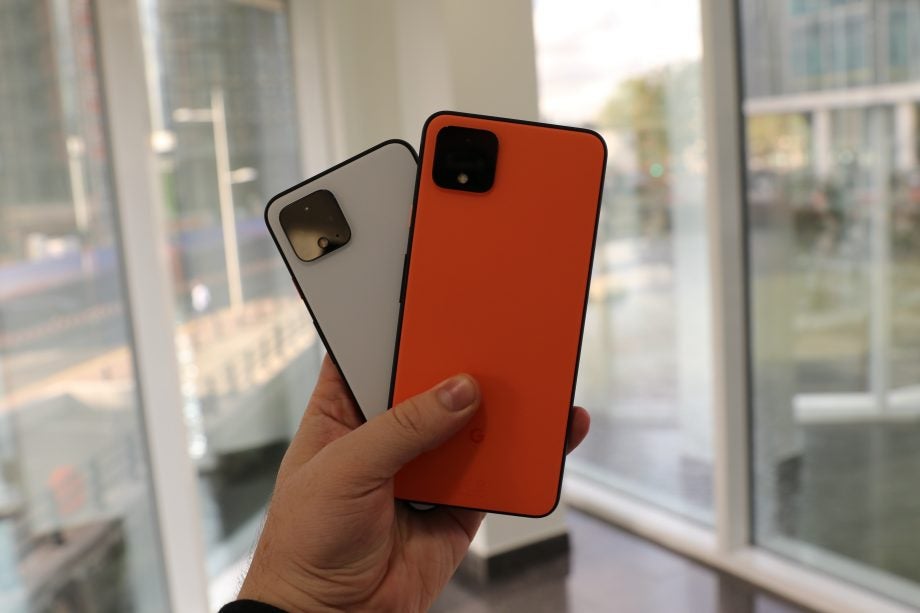Pixel 4 vs Pixel 4 XL: Any other difference than size?

Tempted to pick up one of Google’s new Pixel 4 or Pixel 4 XL phones, but not sure which one is right for you?
You’re not alone, despite both having the Pixel brand there are a couple of key differences between both phones – here’s what they are.
Pixel 4 vs Pixel 4 XL – Specs
On a specs and design front the most notable difference – surprise, surprise – is that the Pixel 4 XL is markedly bigger than the regular Pixel 4. Specifically, it comes loaded with a sizeable 6.3-inch OLED “smooth display” with a razor sharp QHD+ resolution. The regular Pixel 4 has a smaller 5.7-inch, lower FHD+ resolution OLED “smooth display”.
Related: Pixel 4 review – hands-on with the new Google phone
Smooth display refers to the fact both Pixel’s have faster refresh rates than most standard smartphones. It’s a feature that was originally seen on select gaming phones, like the Razer Phone gen’ one, but it’s become more standard this year after OnePlus added it to its OnePlus 7 Pro, OnePlus 7T and OnePlus 7T Pro handsets. The main advantage is that it makes the phone screen smoother to use and slightly more reactive.
The only other big difference is battery size. The Pixel 4 XL runs using a 3800mAh battery, which itself is smaller than most competing flagships, which generally feature 4000mAh cells. The Pixel 4 has a super dinky 2800mAh battery that’s a little small for our liking.
Related: Best Android phones 2019
![]()
Otherwise the phones are pretty much identical, which is no bad thing. They both have reworked dual sensor rear cameras, which look pretty awesome and come with improved AI processing tech and low light night modes. Considering how good Pixel-phone cameras normally are, we have pretty high hopes for both phones imaging quality.
They also both have nifty radar sensors on their front. This is an atypical new feature that lets the Pixel’s, on paper, deliver improved face unlocking and gesture controls that’ll work regardless of how dark it is. This’ll let you do things like skip tracks with a wave of your hand.
Related: Best camera phones 2019
The only slightly odd spec is that both phones run using Qualcomm’s Snapdragon 855 CPU. The 855 is still more than powerful enough to deliver flagship performance, but considering that most other top-tier phones have made the jump to the new 855 Plus chip, it’s presence feels a little odd.
You can see an in-depth breakdown of both phones specs in the table below.
Related: Pixel 4 XL review – hands-on with the new Google phablet
|
Phone |
Pixel 4 |
Pixel 4 XL |
|
Display |
5.7-inch, FHD+, OLED, Smooth Display |
6.3-inch, QHD+, OLED, Smooth Display |
|
Battery |
2800 mAh |
3700 mAh |
|
CPU |
Snapdragon 855 |
Snapdragon 855 |
|
RAM |
6GB |
6GB |
|
Storage |
64GB/128GB |
64GB/128GB |
|
Camera (rear) |
Dual sensor 12-megapixel + 16-megapixel |
Dual sensor 12-megapixel + 16-megapixel |
|
Camera (front) |
8-megapixel |
8-megapixel |
|
Battery |
2800 mAh |
3700 mAh |
|
Authentication |
Face unlock |
Face unlock |
|
Motion sense |
Yes |
Yes |
Pixel 4 vs Pixel 4 XL – Price
The regular Pixel 4 is way cheaper than its plus sized sibling, with the basic 64GB model retailing for £669. The 64GB XL will set you back £829 by comparison. The jump feels a little steep, considering the fact that outside of the screen and battery the two phones have near identical specs and feature sets.
Related: Best phone 2019
![]()
Pixel 4 vs Pixel 4 XL – Early verdict
The Pixel 4 and Pixel 4 XL both look like great smartphones. We won’t be able to gauge which is better until we’ve had a chance to thoroughly review them, but on paper, the XL variant is a little better technically. This is mainly because of its larger battery capacity, with the basic Pixel 4’s cell being a little small for our liking. But with it costing way more than the Pixel 4, we’re thinking the regular smaller version may be way better value for money.


